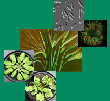Research
Background
Plants – like all other organisms – are able to tightly regulate the intracellular concentration and the distribution of essential metals such as zinc and copper. Also, the cytosolic concentrations of non-essential toxic metals (e.g. cadmium, lead) have to be minimized (for reviews see Clemens, 2001; Clemens, Palmgren & Krämer, 2002; Clemens 2006). Some plant species (so-called metallophytes) can tolerate otherwise toxic concentrations and grow on metal contaminated soil.

Application
The elucidation of metal hyperaccumulation and metal homeostasis in plants is of interest for two main reasons. On the one hand specific traits could be capitalized on for phytoremediation, which means the use of green plants for the removal of anthropogenic contamination (e.g. heavy metals) from the environment. On the other hand the comprehension of metal hyper-accumulation could contribute to the so-called biofortification. This includes techniques for the enrichment of crops with beneficial microelements such as iron or zinc.
Projects
Projects of our institute are aiming at elucidating the molecular mechanisms underlying plant metal homeo-stasis, metal tolerance and metal hyperaccumulation. Plants under investigation are Arabidopsis thaliana and its close relative Arabidopsis halleri, which grows, for instance, on medieval mining sites in the Harz mountains. In addition, we are working with Schizosaccharomyces pombe as a cellular model for metal homeostasis.
› Arabidopsis halleri as a model for metal hyperaccumulation
› Natural diversity
› Phytochelatin synthesis
› Schizosaccharomyces pombe as a model and a tool
› Metabolomics


